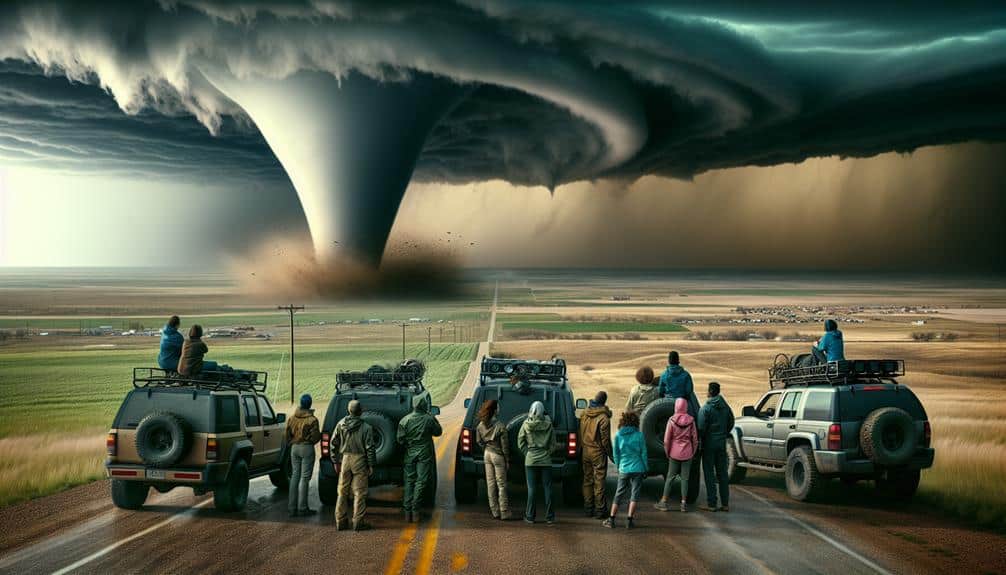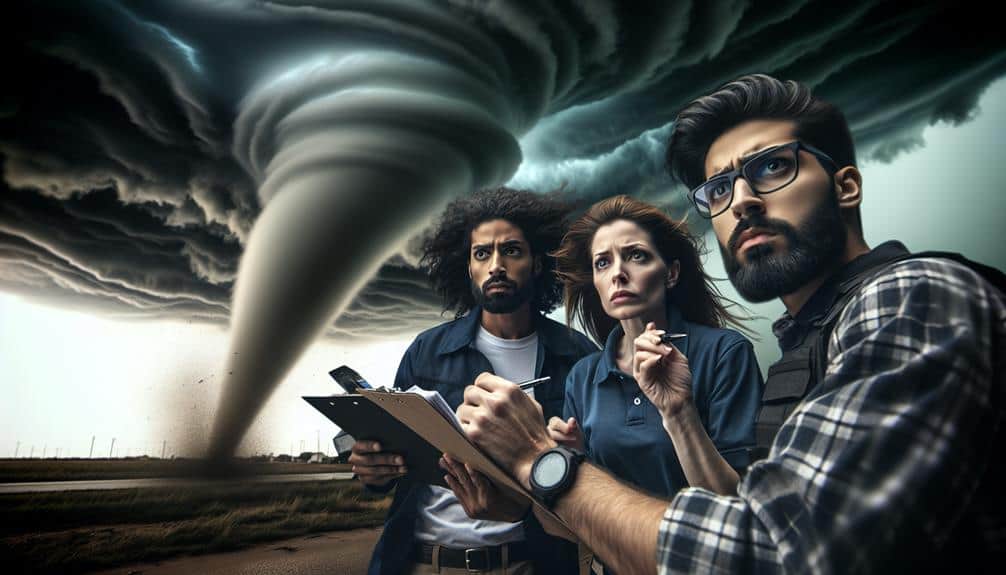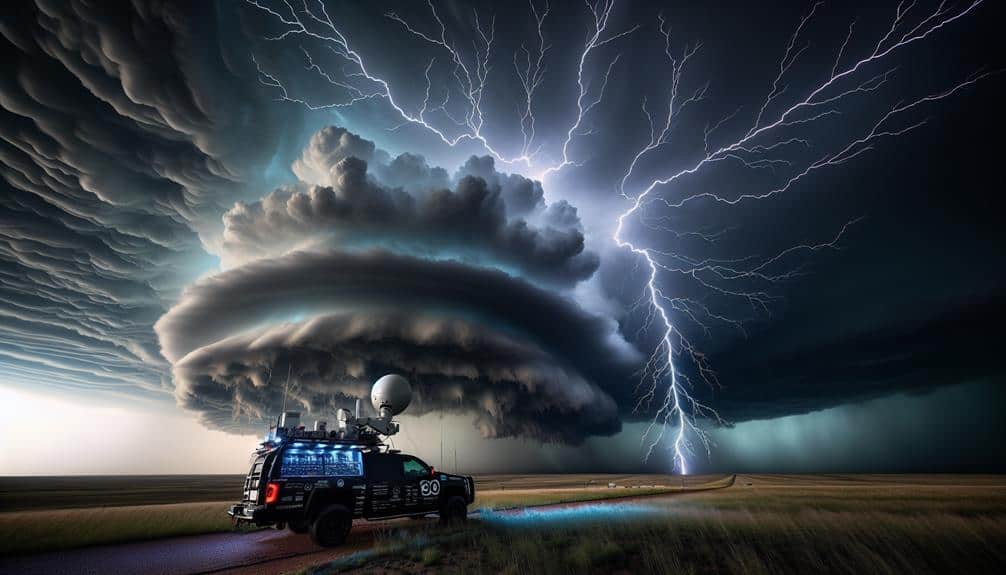As storm chasers, we must comply with various legal regulations to stay safe and avoid penalties. We need to secure appropriate licenses and liability insurance, obtain permits where required, and follow local ordinances. Adhering to traffic laws and maintaining our vehicles is pivotal. We must get property owner permissions to avoid trespassing issues and follow strict drone usage rules. Safety protocols like using protective gear and having evacuation plans are necessary, as is minimizing our environmental impact. Ensuring all these factors are in order is crucial for ethical and responsible storm chasing. Discovering these nuances can greatly enhance our preparedness.
Key Points
- Secure necessary permits and permissions from local authorities before storm chasing.
- Adhere to all traffic laws and speed limit regulations to ensure public safety.
- Obtain liability insurance to cover potential damages or injuries.
- Respect property boundaries by obtaining permission from landowners to avoid trespassing.
Licensing Requirements
To legally pursue storms, we must first understand the specific licensing requirements mandated by various jurisdictions. Each region may have its own set of rules that dictate who can be a storm chaser, what qualifications are needed, and the process to obtain a license. It's essential to research these requirements thoroughly to guarantee compliance.
One primary aspect of licensing involves insurance coverage. We need to secure liability insurance to cover potential damages or injuries that could occur during our storm-chasing activities. This not only protects us but also demonstrates our dedication to operating responsibly.
Safety training is another key component. Many jurisdictions require us to complete certified safety courses that equip us with the knowledge to handle hazardous weather conditions professionally. This training often includes first aid, emergency response, and weather pattern analysis.
Adhering to professional conduct and ethical standards is equally important. Licensing bodies often outline a code of ethics that we must follow. This includes respecting private property, avoiding unnecessary risks, and accurately reporting our findings. Upholding these standards not only guarantees our safety but also maintains the integrity of the storm-chasing community.
Permits and Permissions
We need to examine the necessity of permits from local authorities and the protocols for accessing private property. These regulations guarantee that storm chasers respect jurisdictional rules and landowner rights.
Adhering to these guidelines not only keeps us compliant but also maintains public trust and safety.
Local Authority Requirements
Understanding the specific permits and permissions required by local authorities is vital for legal storm chasing. We need to be aware of local ordinances that vary significantly from one jurisdiction to another. Some areas may require specific permits to enter certain zones, especially during severe weather events. These ordinances are designed to guarantee public safety and minimize disruption to emergency services.
Community guidelines also play an important role. Many localities have established protocols that storm chasers must follow. These may include maintaining a safe distance from the storm, adhering to traffic laws, and cooperating with local law enforcement. Ignoring these guidelines can lead to fines, legal action, or even being barred from the area.
To navigate these requirements effectively, we should do thorough research before setting out. Contacting local authorities for the most up-to-date information on required permits and specific community guidelines can save us from potential legal complications.
Additionally, understanding these rules not only enhances our safety but also respects the communities we pass through. By adhering to local authority requirements, we can enjoy the freedom of storm chasing while upholding our responsibility to public safety and local regulations.
Private Property Access
Gaining access to private property for storm chasing mandates obtaining explicit permission from landowners and, in some cases, securing formal permits. As storm chasers, we must respect property rights and guarantee we've landowner consent before stepping onto private land. This isn't just about following the law; it's about respecting the rights and privacy of individuals who own the land we might traverse.
Here are four essential steps to follow:
- Identify Property Boundaries: Use maps and GPS to determine where private property begins and ends. Knowing these boundaries helps us avoid unintentional trespassing.
- Request Permission: Always contact the landowner directly. Explain our purpose, the time frame, and any potential risks involved. Written consent is ideal.
- Secure Permits if Needed: In some cases, local regulations might require formal permits. Check with local authorities to ensure we're fully compliant.
- Respect Conditions: If the landowner imposes specific conditions or restrictions, we must adhere to them. This might include time limits, areas to avoid, or emergency contact procedures.
Safety Protocols

Effective safety procedures are necessary for minimizing risks and safeguarding the well-being of storm chasers in the field. First and foremost, we must equip ourselves with the right safety gear. This includes helmets, reinforced vehicles, and communication devices like radios and satellite phones. These tools aren't mere accessories; they're our lifeline when maneuvering the unpredictable forces of nature. Additionally, having a well-stocked first aid kit is essential for dealing with potential injuries on the spot.
Next, establishing a clear emergency response plan is crucial. We need to know exactly what steps to take if we find ourselves in a dangerous situation. This plan should outline evacuation routes, safe zones, and contact points for emergency services. Practicing these procedures regularly ensures that everyone knows their role and can act swiftly under pressure.
Furthermore, real-time data and weather updates are indispensable. By constantly monitoring weather conditions through radar and GPS systems, we can make informed decisions and adjust our route as needed. This proactive approach helps us avoid the most life-threatening scenarios.
Traffic Laws
As storm chasers, we must guarantee strict adherence to traffic laws, particularly regarding speed limit compliance and yielding to emergency vehicles. Speeding not only endangers lives but also attracts legal penalties that can hinder our operations.
Additionally, failing to give right-of-way to emergency vehicles compromises public safety and violates regulations designed to facilitate efficient emergency response.
Speed Limit Compliance
Adhering to speed limits is essential for storm chasers to guarantee not only their safety but also the safety of others on the road. It's easy to get caught up in the excitement of chasing a storm, but maintaining proper speed is crucial. We need to understand the risks involved and how to manage them effectively. Here's why speed limit compliance is important:
1. Vehicle Maintenance:
Driving at high speeds can put undue stress on our vehicle's engine, brakes, and tires. Proper vehicle maintenance is pivotal to ensure that our car can handle the demands of storm chasing without breaking down.
2. Insurance Coverage:
Many insurance policies have clauses that void coverage if we're found to be speeding or driving recklessly. Adhering to speed limits helps guarantee that our insurance remains valid, protecting us financially in case of an accident.
3. Reaction Time:
Maintaining a legal speed allows us more time to react to sudden changes in weather conditions, road obstacles, or other drivers' actions.
4. Legal Consequences:
Speeding can result in hefty fines, points on our license, or even the suspension of our driving privileges. Staying within the legal limits helps us avoid these repercussions.
Emergency Vehicle Right-of-Way
Traversing the roads during a storm chase demands that we strictly follow traffic laws concerning the right-of-way of emergency vehicles to guarantee timely and safe passage for those responding to urgent situations. Our adherence to these laws not only secures our safety but also supports the vital work of emergency response teams.
When we encounter emergency vehicles with active sirens or flashing lights, we must yield the right-of-way by pulling over to the side of the road and stopping. This action minimizes road congestion and allows emergency responders to reach their destinations without delay.
Understanding and respecting road safety protocols is essential. We must remain vigilant and aware of our surroundings, especially in areas with high traffic or during severe weather conditions. It's our responsibility to anticipate the presence of emergency vehicles and react promptly to their signals. Failure to do so can hinder emergency response efforts and potentially lead to accidents or further delays.
In essence, our commitment to road safety by yielding to emergency vehicles is a fundamental aspect of responsible storm chasing. It reinforces a cooperative environment on the roads, securing that those in critical need receive the prompt assistance they require.
Trespassing Boundaries

Trespassing boundaries during storm chasing require clear understanding and strict compliance with local laws to guarantee both safety and legality. When we chase storms, respecting landowner rights is essential to avoid legal complications. Trespassing can lead to significant liability issues, not just for damages, but also for any injuries incurred while on private property.
Let's break down some vital guidelines to keep us on the right side of the law:
- Obtain Permission: Always seek explicit permission from property owners before entering private land. Respect their rights and understand that they aren't obligated to grant access.
- Understand Local Laws: Different regions have varying laws regarding trespassing. Familiarize yourselves with these regulations in advance to avoid unintentional violations.
- Mark Public vs. Private: Clearly distinguish between public and private properties on your maps and navigation tools. This helps in making informed decisions on the fly.
- Document Permissions: Keep records of any permissions granted. This can serve as evidence if any disputes arise, ensuring that we've proof of compliance.
Drone Usage Rules
When we operate drones during storm chasing, understanding and following the specific regulations governing their use is crucial to guarantee both legal compliance and safety.
Airspace regulations play a critical role, and we must prioritize our drones remain within designated altitudes and avoid no-fly zones. This includes steering clear of airports and restricted areas to prevent any interference with manned aircraft.
Privacy concerns are paramount. We need to respect privacy rights by avoiding unnecessary surveillance of private properties. Surveillance limitations are imposed to prevent the misuse of drone capabilities, making sure that we don't inadvertently capture footage of individuals or locations where there's a reasonable expectation of privacy. Failing to adhere to these rules could lead to significant legal repercussions.
Moreover, registering our drones with the appropriate authorities and obtaining any necessary permits is crucial. This not only demonstrates our commitment to responsible drone usage but also helps us stay updated with any changes in regulations.
Environmental Impact Regulations

In order to reduce our environmental footprint while storm chasing, we must adhere to regulations that govern land use and wildlife protection. It's important we follow these guidelines to preserve the natural habitats and ecosystems we encounter.
Here's a detailed look at the key regulations:
- Conservation Efforts and Wildlife Protection: We must respect protected areas and avoid disturbing wildlife. This includes following designated paths and observing speed limits that prevent habitat disruption.
- Pollution Control: It's vital to minimize vehicle emissions. Opting for fuel-efficient or electric vehicles can greatly reduce our carbon footprint while chasing storms.
- Waste Management: We should carry all waste back with us. Proper disposal of trash and recyclables ensures we don't contribute to pollution in the areas we visit.
- Land Use Regulations: We need to be aware of and respect land use permissions. This means not trespassing on private property and obtaining necessary permits for any restricted areas.
Frequently Asked Questions
Are There Age Restrictions for Participating in Storm Chasing Activities?
When considering age restrictions for storm chasing, we should prioritize safety guidelines. While some regions don't have strict age limits, ensuring participants' maturity and awareness of risks is essential for their safety and the group's well-being.
How Do Insurance Policies Apply to Storm Chasing?
Isn't it ironic we chase storms for freedom, yet insurance coverage complicates it? Liability issues arise, and policy exclusions can void claims. We must scrutinize our insurance policies and understand the claims process before storm chasing.
What Are the Legal Implications of Selling Storm Footage?
When selling storm footage, we've got to take into account copyright laws and ethics. We must respect privacy rights and make sure the footage's commercial use doesn't infringe on individuals' rights or exploit sensitive situations. Let's stay ethical and legal.
Can Storm Chasers Be Held Liable for Injuries to Others?
We must address liability concerns directly. If storm chasers don't take proper safety precautions, they can be held liable for injuries to others. Our actions should prioritize safety, ensuring we're not endangering anyone in pursuit of freedom.
Are There Any Legal Protections for Storm Chasers Against Harassment?
Like a shield in a storm, legal protections for storm chasers against harassment focus on privacy concerns and safety precautions. We must guarantee our safety while respecting others' boundaries, balancing our freedoms with responsibility.


